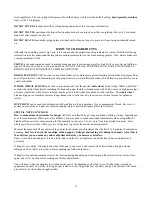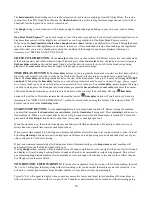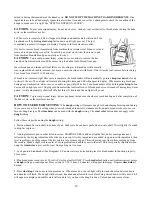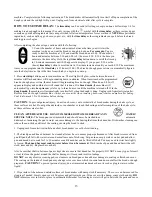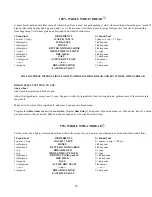
9
ADAPTING YOUR FAVORITE BREAD/DOUGH RECIPES
:
After you have prepared some of the
recipes in this book, you may wish to adapt some of your favorite conventional bread recipes to the bread maker. Some
experimentation will be required on your part and you will need to check the condition of the dough during the knead cycle
for any minor adjustment that may be needed in liquid or flour. Either use one of the recipes in this book that is similar to
your recipe as a guide, or use the formula that follows:
For
each
cup of
flour
used in recipe use:
3
ounces liquid, 80° F
½
tablespoon fat
½
teaspoon salt
½
tablespoon sweetener
scant ¾ teaspoon active dry
or
½ teaspoon bread machine/fast rise yeast
For example,
based on the formula above using 3 cups of flour, start with:
9
ounces liquid, 80°F
1½
tablespoons
fat
3
cups bread flour
1½
teaspoons
salt
1½
tablespoons sweetener
2
teaspoons active dry
or
1½ teaspoons bread machine/fast rise yeast
Add ingredients to the pan in recommended sequence: liquids first, followed by fat, then all dry ingredients except yeast.
Level dry ingredients in pan, make a slight well and add the yeast to well. Program for
basic/specialty
setting,
medium
crust color. After 10 minutes of continuous kneading, check the condition of dough. It should be soft, a bit sticky with a
slight smear of dough under the knead bar. If too wet and sticky, add one (1) tablespoon of flour at a time until dough
gathers into a ball and does not cling to sides of pan. If too dry and motor is laboring, add one (1) teaspoon liquid at a time
until the dough becomes more pliable.
DO NOT EXCEED 3 CUPS OF BREAD FLOUR FOR A 1½ POUND LOAF; 2 CUPS OF FLOUR FOR A 1
POUND LOAF.
SLICING BREAD:
Always allow bread to cool at least 15 to 30 minutes before slicing. If you attempt to slice the bread
immediately after baking, it will be very difficult to slice and will be sticky.
STORING BREAD
:
Since homemade bread contains no preservatives, it does not stay as fresh for as long as
commercially made bread. Store your bread in a plastic bag or sealed storage container to keep it from drying out. Keep the
bread at room temperature or in the refrigerator for up to one week. For longer storage, put the bread in freezer. Slice before
freezing so you can remove only the number of slices you need at a time.
BECOME FAMILIAR WITH CONTROL PANEL
:
The control panel on
your bread maker was designed to be very easy to use. Please review the following
features to better understand what each button on control panel is designed to do
and the options that are available to you.
BREAD SELECT BUTTON
:
The
bread select
button lets you choose
between a number of different bread settings as well as a dough setting. With each
press of the
bread select
button, the indicator arrow will point to a bread or dough
setting on the control panel. The time required to complete each setting also
appears in the display.
The bread select settings offered are:
basic/specialty
3:10 (medium crust)
whole wheat
3:40 (medium crust)
dough
1:20
one-hour
1:00




